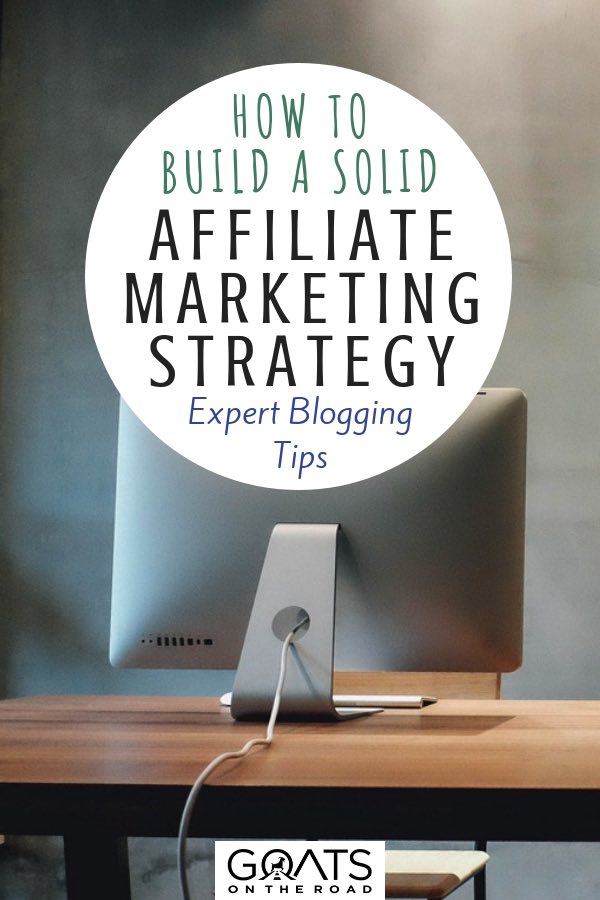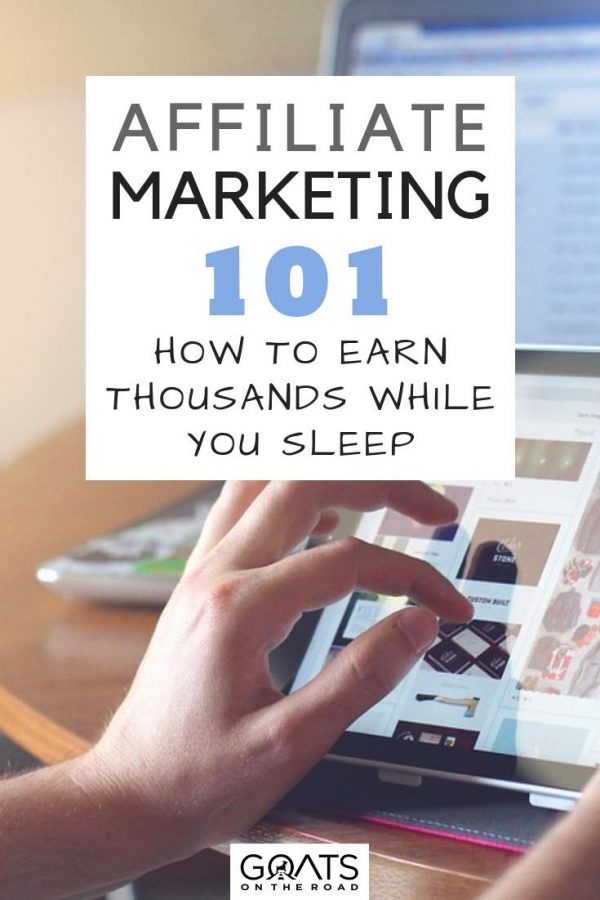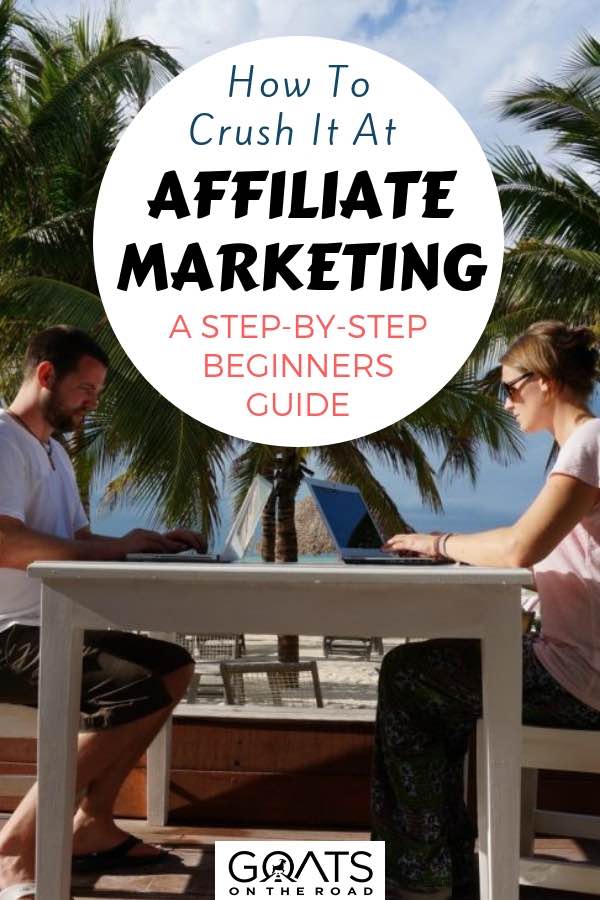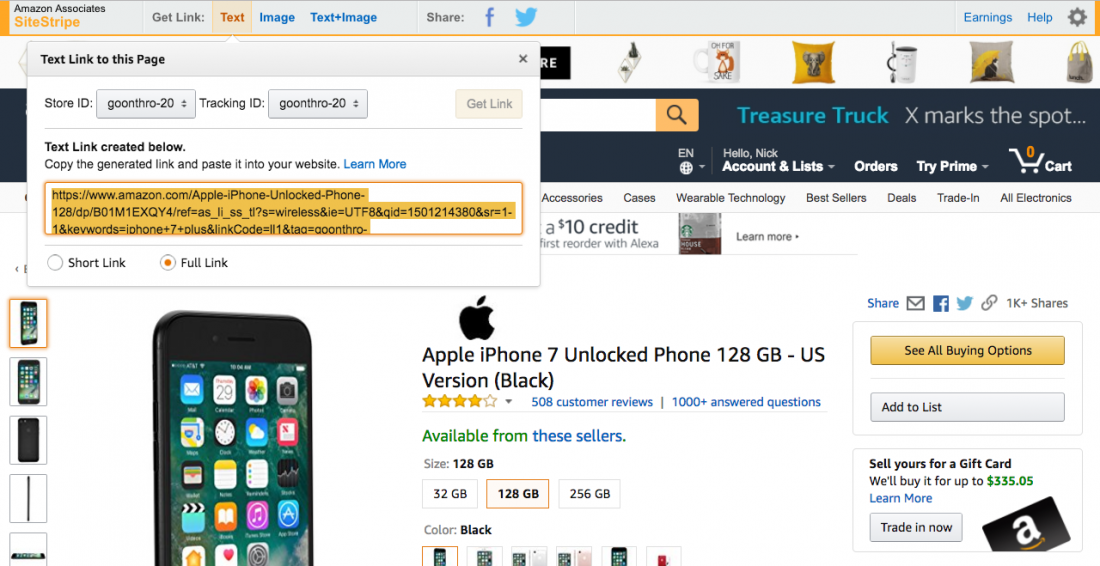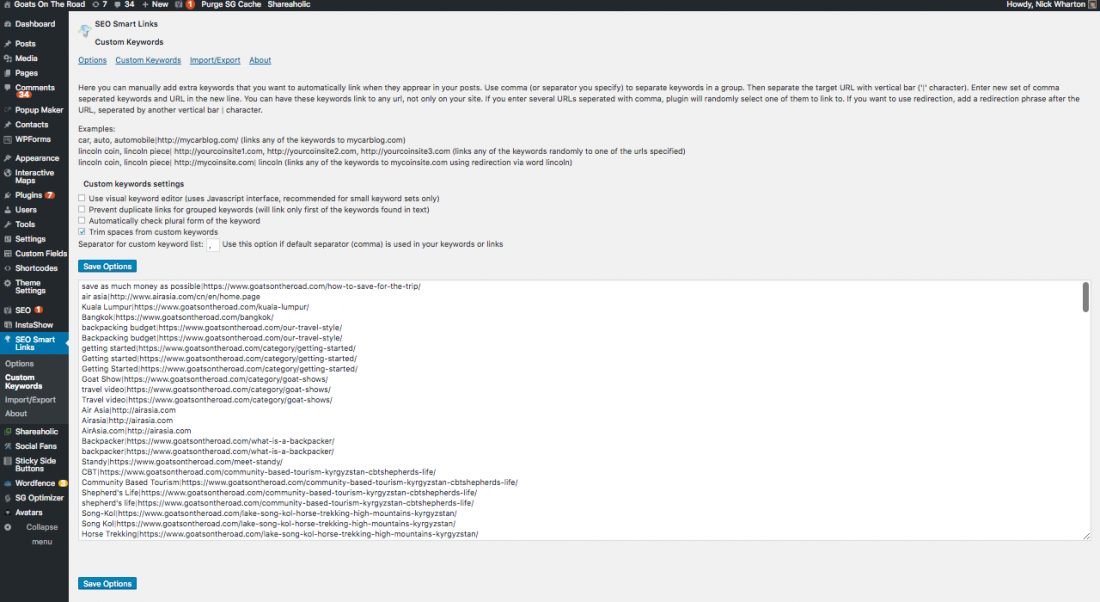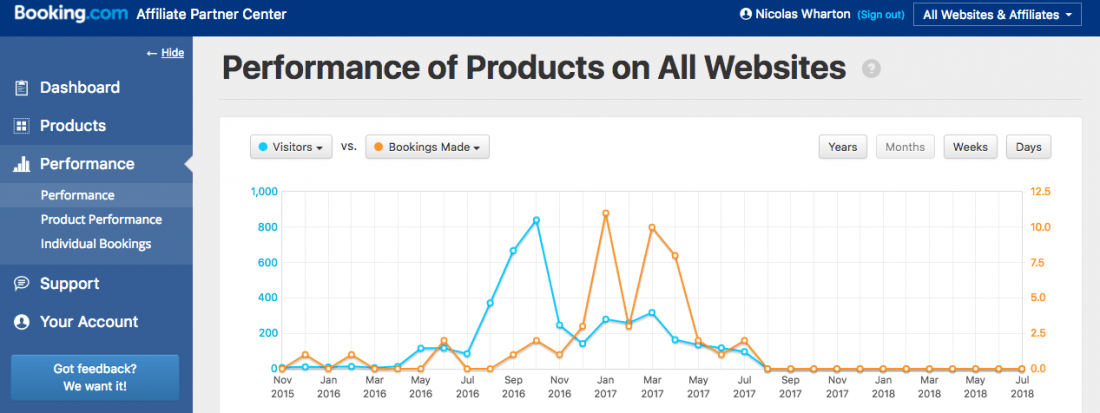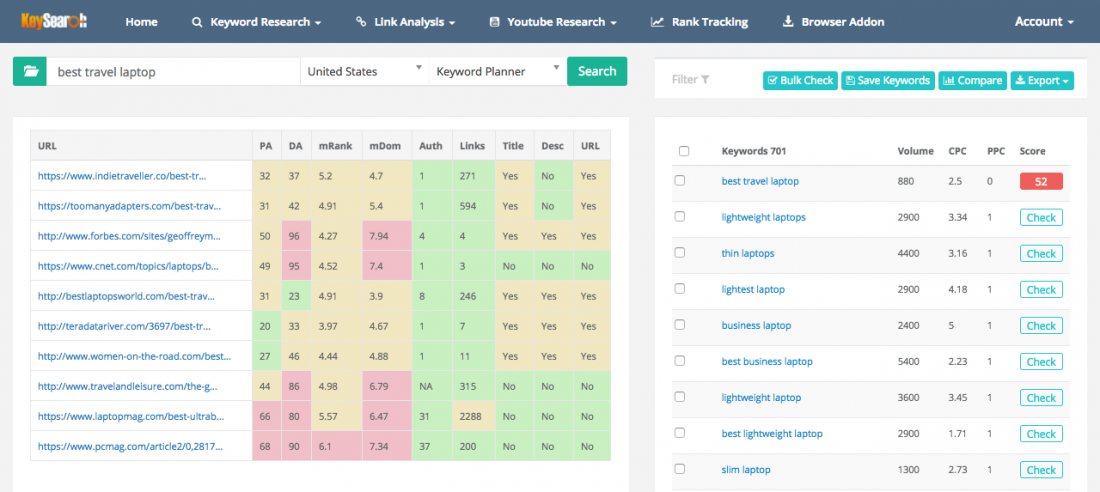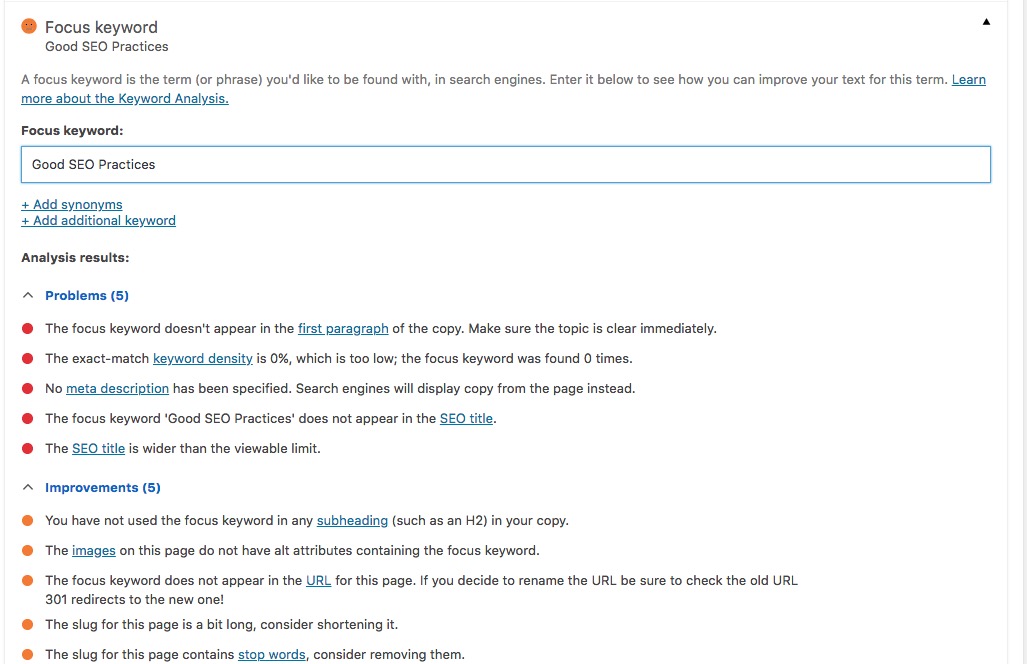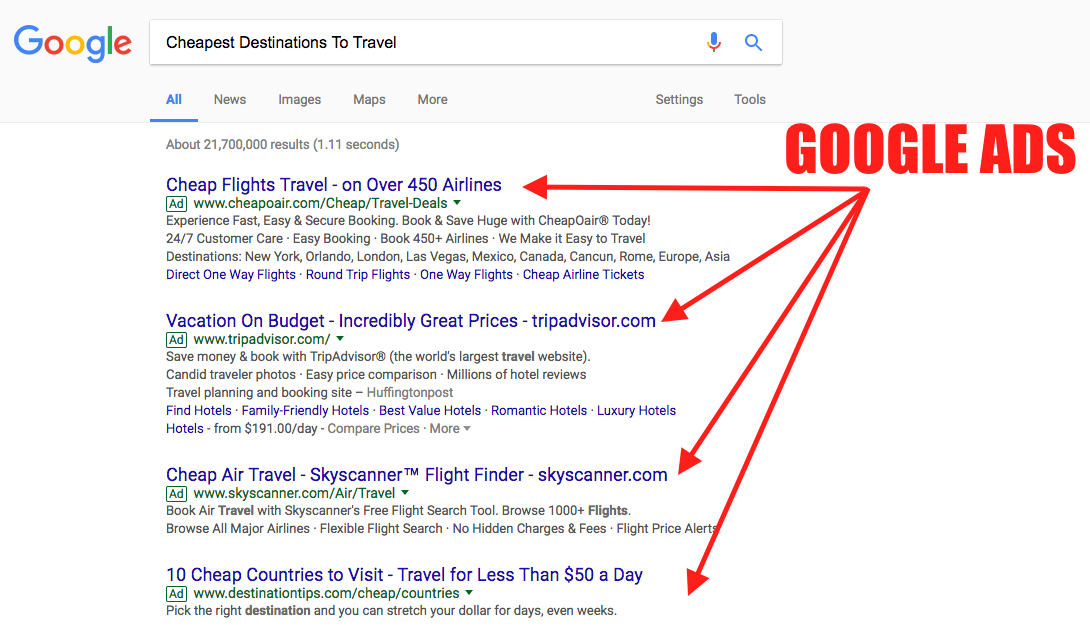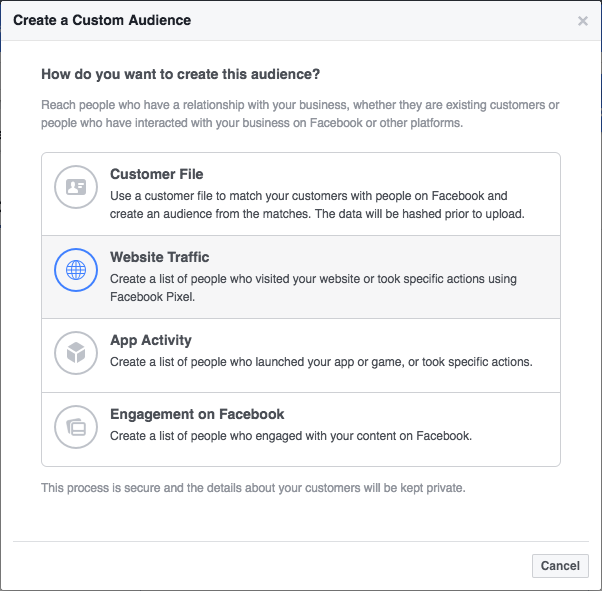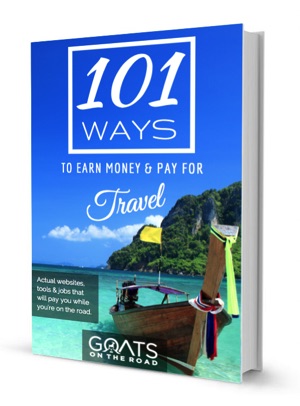Affiliate marketing is the single best way to earn money online, mainly because it’s a set it and forget it type business model. Spend time creating great content that recommends something that your readers are interested in, use an affiliate tracking link, build up that article’s traffic through SEO and social promotion and boom, start earning money without any further time investment on your end.
It doesn’t cost your readers anything extra to book through your links, but the commission you earn will help keep your site up and running.
When we started dabbling in affiliate marketing a few years ago, we really didn’t know much about it, but over time we’ve learned how to rank for search terms, choose products that sell and earn up to $10,000 / month in our sleep.
Surprisingly, the steps to being a great affiliate marketer are pretty simple and while it may take you a while to hit the jackpot, all of the hard work is definitely worth it. We know quite a few people (including ourselves) who are making thousands of dollars per month from one post, and others who have affiliate income of over $100,000 per month.
It takes some time to understand your readers and your audience, do appropriate keyword research, build traffic to certain posts and A/B test your results, but once you have a few posts earning real affiliate income, you can sit back, relax and watch the money roll in.
In this article I’m going to explain what makes a good affiliate strategy, share with you the best affiliate networks for travel bloggers and even get you started on keyword research for your first affiliate post so that you can hopefully earn some money from affiliate marketing in the next few months.
Do You Need Traffic To Make Affiliate Sales?
The short answer to this question is yes.
The more traffic you have, by default, the more sales you’re likely to make. But please don’t make the mistake of thinking that if you only have 1,000 page views per month, you can’t earn any affiliate income. In this post I’m going to show you proven SEO strategies that will drive the right traffic to your affiliate posts.
It’s all about knowing your audience and their interests and understanding the customer journey so that you can write articles that are more likely to convert your readers into customers / purchasers.
If you’re a travel blogger, then for sure you know that your readers are interested in travel so they’ll likely book flights, hotels, travel insurance, tours and maybe buy some Amazon travel products through links on your site.
It’s great to have this narrowed down, but you need to narrow this down even further, which is why it’s so important to carve out a niche and understand what niches can be profitable.
Our blog has over 200,000 unique visitors per month (at the time of writing), which helps us to get some affiliate sales, but before we figured out who our readers were and how to get targeted traffic to the right posts, we were hardly making any money through affiliates.
There are big sites out there with 100,000+ unique visitors per month making $0 from affiliates, while there are also smaller blogs and websites with only 1,000 unique visitors per month who are able to make thousands per month. It’s all about what products you recommend and what affiliate posts you write.
Know your readers, write posts and recommend products and services that they’re likely to buy. If you only write about travel in Central America, then you should have affiliates for Central American tour companies, airlines and hotels.
To be sure that you’re writing posts that are in the right position in the buyer’s journey to earn money, think of when you would be most likely to buy. When you’re searching the web for “travelling to Thailand” for example, you are probably just reading a bit about the history and things to do in Thailand. In this case, you’re not likely booking your hotels or purchasing travel insurance. But if you search “Where to stay in Bangkok”, you’ll find a list of amazing hotels and you’ll be much more likely to click a link and book a hotel.
Think of terms that people are searching when they’re ready to book. Things like “the best travel insurance for travel”, “where to stay in _____”, “best hotels in _____” and “best tours in ____” are more likely to convert readers into buyers and thus earn you that much appreciated affiliate commission.
Where Do You Find Affiliates?
There are loads of different affiliate networks out there, as well as a few companies that have their own direct affiliate networks. A good place to start is to look at all of the services you use currently for travel, and then run some Google searches to find out if they have affiliate programs.
For example, maybe you book all of your rooms on Booking.com. A quick Google Search like “Booking .com affiliate program” would bring up their own affiliate dashboard where you can sign up and join.
Same goes for World Nomads Travel Insurance, Amazon, Expedia and a few other travel / product services.
Many affiliate partners these days are run through affiliate networks. These websites are massive aggregates of different companies. They’re handy because they keep multiple affiliates in one dashboard so you can track sales and conversions from many different companies without having to sign into multiple websites and dashboards.
The best affiliate networks for travel products and services include:
- CJ.com
- Awin
- Share-a-sale
- World Nomads Travel Insurance
- Amazon
- Booking.com
- Hostel World
- Agoda
- Hotels Combined
- Airbnb
- Get Your Guide
To join these networks and begin earning affiliate sales through them, simply click on the links above, sign-up, search their affiliate database and request to join affiliate programs that match your niche.
How To Add Affiliate Links
Once you’ve chosen a few affiliates that you think will be a good fit for your blog (the more the better), you can start implementing them onto your site.
The way affiliate links work is that they have a special bit of code in the URL that tells the company or affiliate network that the sale came from you. So if you sign up for the Amazon affiliate network for example, your affiliate link for a specific product page might look like:
https://www.amazon.com/Product&tag=goonthro-20
The link will likely be a lot longer, but that bit where it says &tag=goonthro-20 shows that it’s using my Goats On The Road affiliate link. So long as the URL in the affiliate link that you’re using includes some kind of tracking for your account, it should work fine.
If you have any doubts, it’s sometimes worthwhile to contact the support for the affiliate network and ask them to confirm that the link is tracking properly. Each affiliate dashboard will tell you what your tracking code is so that you can ensure it’s properly included in your links.
For my Bluehost web hosting affiliate link, this tracking code looks like this https://www.bluehost.com/track/gotr/
The tracking code is different for every affiliate network and company, but generally speaking, if you’re adding a link and it doesn’t have some kind of tracking code in it for your account, it’s probably not tracking properly.
Amazon has a great affiliate program because after you create an account and sign in, while you’re browsing Amazon, there’s a handy bar at the top of the screen which will allow you to pull your affiliate link from any product page on the site with a few simple clicks.
Similarly, Awin has a great plugin for Google Chrome and other browsers that allows you to easily turn any URL of an affiliate page into your own tracking link.
Other affiliates aren’t so easy.
With Booking.com for example, you have to sign-in to their affiliate dashboard, then in another tab, find a property you want to link to, copy the URL of the property on the Booking.com website and then go back to the dashboard, paste in that link and get a tracking link for your account. Or you can memorize your “booking AID” and replace it in the URL for any page on their site.
It can be a cumbersome process sometimes, but it’s worth it if you want to earn money through affiliates.
Every single time that you talk about a product, a hotel room, a rental car, a flight booking engine, a tour or a travel service on your blog, you should try to be linking out to an affiliate so that you can earn money from it. If you’re not an affiliate yet, run some Google searches to see if there’s an affiliate program, join it, and use an affiliate tracking link.
If you already have dozens of articles written that you think you can add these types of links to, you should go back on them and manually add links to them, and / or, use the SEO Smart Links plugin to add site-wide affiliate links to your blog (more on that below).
WordPress Plugins For Affiliates
GeniusLink
I originally had this plug-in listed in this article because it was an easy way to ensure that any of your visitors to your website were directed to the proper Amazon store (US, Japan, Canada etc.) upon clicking your affiliate links, however, due to recent changes by Amazon (July 2017) this is no longer necessary and comes standard for Amazon Affiliates.
EasyAzon
This plugin is a real time-saver. Traditionally if you wanted to add an Amazon affiliate link to one of your posts, you’d have to open a new tab, search for the product on Amazon, copy your affiliate link and then go back to the post editor screen in WordPress to paste in the tracking link URL.
EasyAzon is a WordPress plugin that removes needless extra steps. When you highlight the text in the edit post screen and choose to link it, EasyAzon will search Amazon to see if there’s a relevant product to link to. If so, it gives you many options for linking and with the Pro version of the plugin ($47) also gives you options for live price updates, buy now buttons and styled boxes.
SEO Smart Links Plugin
This is an excellent plugin for adding affiliate links to your entire site, even for posts that you’ve already published, without having to do them one at a time. For example, if you want the link to your World Nomads affiliate to appear every time you’ve typed words like “travel insurance” or “World Nomads” in a blog post or page on your website, this plugin makes it easy.
Simply install the plugin, then in your WordPress dashboard click “Custom Keywords” under the new SEO Smart Links plugin and there you’ll be able to add in infinite keywords and the affiliate links that you want to auto-link them to.
You can also use the plugin for internal links to affiliate packed posts that you’ve written on your site. Maybe you’ve written a great post called “Best Travel Backpacks” on your site. You can tell the plugin to link the words “Travel Backpacks” across your entire website to that post to try to drive more traffic, boost SEO for that keyword and get more sales.
Yoast SEO Plugin
This plugin will help you when we get to the SEO part of affiliate marketing. If you want to drive traffic to your new affiliate posts, then you have to make sure they tick all the boxes for basic on page SEO. This plugin will help you to do this. More on Yoast SEO Plugin for WordPress later in this post.
SEO will really be your key to earning money through affiliate posts. If you can rank #1 in Google for a valuable term (like “Where To Stay in Rome“) then you can potentially earn thousands of dollars per month on hotel affiliate sales. We’ve gone into more depth about SEO and keyword research in our Beginner Blogger Course, and we’ll soon be coming out with an SEO Master Course to help you rank for valuable terms quickly, and earn consistent money in as little as 60 days.
Click Here to subscribe to our newsletter and get notified when our new SEO course becomes available.
Tracking Sales & Conversions
It’s important that you continuously check your traffic, your links and your affiliate dashboards to know where your sales are coming from. This can help you to understand your readers and what they’re purchasing from which pages on your site, but will also give you the opportunity to ramp up links for certain products or services that are converting well.
Any affiliate, whether it’s direct with the company or through an affiliate network like CJ, will allow you to track your sales within a special dashboard. To access this dashboard, you’ll have to sign into your affiliate account.
In Booking.com for example, you head to this Partner Login page (if you have already signed up for an affiliate partnership through booking .com), log in and then click Performance. This will bring you to a screen like the one pictured below:
From this dashboard you can find out how many sales you’ve made per month, which posts the sales are coming from on your blog, how many clicks you’ve had from links on your blog and how much you’ve earned.
Every affiliate and affiliate network has its own dashboard, but basically they have the same information. You can usually also find other affiliate tools like widgets that you can embed on your site for direct bookings, banner ads, pre-made links and affiliate pages.
Once you sign up for multiple affiliates and affiliate networks, you should go into these dashboards and get familiar with them. Find out what tools and tracking methods you can use to better your conversions and implement different
GDPR & Disclaimer Laws
As much as bloggers and affiliate marketers cringe at ever-changing GDPR guidelines, the fact is that they help protect consumers from unwanted advertising. I personally dislike the fact that I have to add countless disclaimers to our blog posts and links because I think it takes away from the reading experience, but what I hate more is when companies try to sneak ads into television shows and websites without the consumer knowing.
Whether you like it or not, the FTC will affect your affiliate marketing habits and even if you’re adding links to a site that’s not targeting US traffic, if you’re making sales through any American Amazon store (which is by far the most active in the world), then you’ll need to follow the rules.
Here’s what the FTC says about affiliate marketing in blogs:
In some instances – like when the affiliate link is embedded in your product review – a single disclosure may be adequate. When the review has a clear and conspicuous disclosure of your relationship and the reader can see both the review containing that disclosure and the link at the same time, readers have the information they need. You could say something like, “I get commissions for purchases made through links in this post.” But if the product review containing the disclosure and the link are separated, readers may lose the connection.
Basically it’s unclear whether you absolutely need to include a disclaimer along side the link every time you create a link on your site. At the very least, you need to have a disclosure at the top and bottom of your post that not only identifies the forthcoming links as “affiliate” but also the fact that “affiliate” means that you receive a commission.
The GDPR has its own set of laws governing privacy and how data sets and cookies are collected. Basically if you are collecting, processing, or storing personal data from EU customers who visit your site, you must only obtain that data through opt-in consent, contractual necessity, a legitimate interest, a vital interest, a public task, or a legal obligation.
If you’re storing cookies (automatically done in most cases with affiliates) you need to create a Privacy Page which is linked to from every page on your site (ie: menu, header or footer). This Privacy Page must include all of the different ways your site collects and stores data. You must also make 100% clear which links are affiliate / sponsored links and which are not. Usually a disclaimer within the post or (more ideally) within the same paragraph to explain that the post contains affiliate links.
This is how we generally word our disclaimer:
Note: Some links in this article are affiliate links, which means that we get a small commission each time you purchase something through them. This will NEVER cost our readers any extra, and in most cases there are special Goats On The Road discounts of up to 50% off that you can only get by clicking links within our blog. We only recommend products and services which we trust and we appreciate you supporting us by using our links for your online purchases. To ensure that the links are trackable, our website may store cookies on your browser. See our Privacy Page for more info.
You should also have a popup disclaimer that explains how your site stores cookies with a clear button for people to agree to the terms, or visit your Privacy Page. You can download a plugin to do this.
If this all seems overwhelming, don’t worry! WordPress has a lot of tools to easily guide you through the process to ensure that your website is compliant.
How To Practice Good SEO
SEO is an extremely important aspect to becoming a successful affiliate earner. Even if your blog doesn’t have a lot of traffic, you can drive focused traffic to certain posts on your site which include valuable affiliate links.
SEO stands for Search Engine Optimization and it represents the practice of optimizing blog posts and web pages for search engines and then linking back to them from trusted sources, using varied but focused anchor texts.
There are a few steps to good SEO which I will break down now.
STEP 1 – Keyword Research
If you’re an SEO guru, then before you write any post on your site you’ll make sure that you do proper keyword research. This means that you’re checking to see what people are searching in Google and then writing your post using those keywords so that you can gobble up as much of the traffic as possible.
Firstly, you need to get a Google AdWords account. It seems strange that you have to get a google advertising account before you can search for keywords, but it’s just the way it is. In AdWords is where you’ll find the Keyword Planner, which is your first stop in keyword research.
Within the keyword planner, you’ll be able to input numerous keywords to test them and see how many searches per month they receive in Google.
Let’s say you test 5 keywords:
- Best Laptop for Travel
- Best Travel Laptop
- Most Compact Laptop
- Best Lightweight Laptop
- Top Portable Laptops
Google’s Keyword Planner will show you exactly how many times people search those words in Google each month. You should obviously choose the keyword with the most searches and create your post around that.
Google’s Keyword Planner is a great tool for beginners and it is totally free, but like many free online tools, its power is limited.
Anyone who seriously wants to bring traffic to their site will have a paid keyword research tool. I personally use KeySearch and I find it to have a very simple interface, great results and all the data that I need.
KeySearch is currently offering Goats On The Road readers a 20% discount off of their rates. Simply Click Here and then use code KSDISC at check-out. You’ll want to upgrade to a starter account for $17 per month and then eventually a pro account for $34 per month, which will give you full access to the tool’s features, as well as (most importantly) unlimited keyword searches and analysis.
Using KeySearch, you can take your keyword research to the next level. Type in the keywords that you’re interested in (just like in Google Keyword Planner), but this time, when you hit search the tool will bring up a lot more information.
The most useful information is the top 10 searches in Google. This shows you the websites that are currently ranking in the top 10 spots in Google.
It will show you the amount of links they’ve built to the ranking post (including internal and external), the Moz Page Authority (PA) and Domain Authority (DA) of the sites and whether or not the post includes vital SEO information like a snippet, title and URL including the keyword.
Using this tool, you can find keywords that have a lot of searches (1,000 minimum) and not too difficult of competition in current Google results. In the example above, you can see a considerable amount of green, which means that competition isn’t too hard for this particular keyword.
The “Links” column is actually not as important as the “Auth” column, because it includes internal links. The “Auth” column shows how many external domains are linking to that post. Try to find results where the top 10 results in Google don’t have more than 20 links built under “Auth”.
It’s very difficult to build links, so make it easy on yourself and find terms that are less competitive. Basically if you’re a new blog and you’re looking to rank for a valuable keyword you should pick a word that you think people are typing into Google when they’re ready to buy. Then you should check KeySearch to make sure that keyword is searched at least 1,000 times per month (ideally 1,000 – 5,000). If that keyword is also green in KeySearch difficulty (35 difficulty and under), then go for it!
STEP 2 – Writing SEO Rich Content
Now it comes to the part where you have completed your keyword research, found a few related keywords that you hope to rank for, and you’re now ready to write a post. This post needs to be epic. I mean a guide to everything you need to know on the topic.
You should have comparison charts, calls to action (CTA like “Click Here to Book Now”), images, prices… everything! The post should be 5,000 – 10,000 words and contain at least 0.4% desnity of your chosen keywords within the text, including in the title, URL, description, opening sentence and a high concentration of keywords in the first 3 paragraphs of the post. Yoast will help you do this.
You can have multiple keywords in a single article that you hope to rank for as well. It’s a good idea to write down a keyword plan on a piece of paper to make sure you have enough of your chosen keywords in key parts of the article.
Now that you’ve written the most epic post possible, you need to have the Yoast SEO Plugin for WordPress installed on your WordPress blog. After you’re done writing the first draft of your affiliate post, you should scroll down to the bottom of the edit post screen where you’ll see a Yoast SEO tab.
This little tab will help you with countless on page SEO tools including word count, readability, focus keyword count, focus keyword placement, snippet edit, image alt tag check and so much more. Each SEO point will be next to a colored dot. Green means you’ve done a great job, yellow could use some work and red means you definitely need to fix it.
STEP 3 – Creating Back Links
Now comes the hard part, especially for newbie bloggers who don’t have a large network of top blogs willing to link back to them. For most, creating back links properly and safely means that you’ll be writing numerous guest posts. If you know bloggers well, don’t be afraid to email them and ask them to add a link to your post and a paragraph in one of their existing articles.
DO NOT cold call bloggers who you’ve never talked to and ask for links. From a blog who gets a lot of these emails, I have to say that they’re annoying and somewhat rude. Try to offer something in exchange for the link, pitch a guest post or explain why it’s useful to their blog and always try to start a conversation before simply asking for a link.
After you’ve done keyword research, written your epic post and used Yoast to ensure that you’ve included the keywords in all of the right places and the post is SEO ready, it’s time to build links back to that post.
Remember those keywords you found using Google Keyword Planner and the KeySearch tool? Now you need to get other blogs to link back to your new post using those keywords (and variations of them) as the anchor text.
If you’re wondering what anchor text is, it’s the actual text that you use to link to a website. In this example: Travel Packing List for Women the anchor text is “Travel Packing List for Women”.
If you’re a new blogger and you don’t have a large network of bloggers who you know well enough to ask for links, then you’ll have to write a lot of guest posts. The amount of guest posts you have to write to rank #1 in Google will vary, but you should create more than the first result has in Google, which you found in the “Auth” column in KeySearch.
Let’s say that in the top 10 results of KeySearch, the highest number in the Auth column was 20. That means that you have to build 20 back links to your post in order to have the best chances of beating out your competition and ranking #1.
Keep in mind that not all back links are created equal. You could get 20 back links from DA1 sites (websites which have a Domain Authority of 1), but that won’t be worth as much as one back link from a DA20 site.
Use Open Site Explorer to find blogs with a domain authority of 15 or higher that you think you could guest post on. Create a spreadsheet of 50 or more blogs that you hope to guest post on that follow this guideline and then start reaching out. You may find that you only get responses from 20% of those bloggers and of those, only half allow you to guest post, but it’s worth the time if you do it right.
Once you have a list of 20 or more blogs that you can guest post for, it’s time to start writing. Make sure that when you write your guest posts, you use the keyword that you want your article to rank for as your anchor text when linking back to your post. Don’t just link to your home page. You need to link back to that specific post 20 times using the keyword you found as the anchor text as well as some minor variations of it (“click here”, “this post”, etc).
Note: Never build all of your links at once and don’t link to the same post with more than 10 exact keyword matches in the anchor text. Google thinks this looks spammy and could penalize you. Also, don’t just do mass link exchanges with other bloggers. You should form link triangles instead of direct trades and always include a new paragraph if you’re adding links into existing articles.
Don’t Forget About Internal Links
This is a part of SEO that so many people forget about. Not only should you be building backlinks from other domains, but every time you write an SEO post, you should go into at least 10 of the other posts on your site (preferably relevant to the topic) and link back to the main SEO post with the focus keyword.
The more internal links the better, particularly if the links are from topics that are extremely relevant to the main post. If you don’t have any relevant posts, consider writing them (1,000 words minimum) and then link to the main post from them. These are called supporting articles and they’re very good for SEO.
STEP 4 – The Waiting Game
The final step of the SEO process is waiting. Google takes a long time (sometimes 8 – 10 months) to index your post and track all of the links that you’ve built. You need to be patient. You can continuously build new links to the post over those 8 – 10 months, but just know that you’re not going to rank overnight.
Once you start ranking, if you wrote your article well and used good calls to action, you should start seeing some affiliate sales!
Creating Ads For Affiliate Posts
Once you know that you have a high-converting affiliate post, you may want to consider creating some ads to drive additional traffic to the site. You can create ads using the more traditional route of using Google Ads, or do what most affiliate marketers do today and use Instagram and Facebook Ads instead.
Ads With Google AdWords
Google Ads show up in search results at the top of each page next to a small orange box that says “Ad” like the image below:
To create an ad like this, simply log into your Google AdWords account (which you should have already started for the Keyword Planner we talked about earlier in this post) and then start a new Ad Set.
From here you can choose which keywords you want your ad to appear under in Google results. Then you have to choose to place your bid. The higher you choose, the more likely Google is to run your ad.
Google gives you an “Estimated CPC” which helps you decide if you want to bid on the keyword. CPC means cost per click and it’s pretty self-explanatory, if the CPC is $1 and your ad gets 100 clicks from Google, it’ll cost you $100.
Niel Patel describes the equation brilliantly:
For example, let’s say your average profit per customer is $500, and out of 1,000 website visitors you convert 10 into customers. That means you have a 1% website conversion rate. If you are comfortable with a 30% profit margin, then here’s how you would calculate your Max CPC: Max CPC = $500 x (1 – 0.30) x 1% = $3.50 Again, your Max CPC must be in the neighborhood of the estimated CPC in Google’s Keyword Tool or else you’re in trouble. If your Max CPC is $3.50 and the estimated CPC for a keyword is $10, then you’ll need to first increase either your profit per customer or your conversion rate before you can profitably advertise on that particular keyword.
Max CPC = (profit per customer) x (1 – profit margin) x (website conversion rate)
For high competition keywords like “Best Travel Insurance”, these bids are often well over $5 per click which is too high for the average travel blogger, despite the often high commission rate per sale. Once you choose your keywords that you want to create Google Ads for, you’ll have to decide how high you should bid based on the CPC equation above.
Facebook Ads
Since Facebook purchased Instagram back in April of 2012, you will actually create ads for both of these platforms within the Facebook Ads Manager.
To get here, sign into Facebook and then click Ads Manager under your profile drop down at the top right of your screen. From Ads Manager you’ll want to create a new ad.
To create an Ad that simply sends people to your high-converting page, all you have to do is click the “Traffic” option in Ads manager and go about the normal steps of choosing a well-defined audience and an affordable budget.
Then choose the image for the ad and the URL you want to link the ad to. Facebook will show you how your ad will look to users, so you can tinker with it to try to entice people to click on your ad.
Now you will choose the targeting of the ad.
Make sure you choose interests that pertain to the post you’re sending them to. For example, if you’re sending people to a page where they can purchase Amazon products from your post “Best Shoes For Women”, then you should make sure you’re targeting females only, who have an interest in shoes and travel (for example).
If you’re trying to remarket readers who have visited your important pages, but didn’t convert, you can easily do this with Facebook Ads. If someone visited your Top 50 Cheap Countries in the World eBook page, but didn’t end up buying it, you can remind them with a nice little ad in their Facebook feed.
Another handy way to use Facebook ads is to remarket people who have visited your site, but didn’t convert. You can do this by creating a custom audience and use your tracking pixel to target people who have been to certain pages on your site.
To do this, you have to first add a Facebook Tracking Pixel to all of the pages on your website. After you do that, you can choose a custom audience in the audience section of Ad Manager. Then you can choose “People Who Have Visited Specific Pages On Your Website”.
Want to target everyone who read your post about Best Women’s Shoes but just didn’t buy, this is the perfect ad to create.
If you choose specific pages, you simply enter the URLs of the pages that you want to target and voila. If someone visited those pages in the past 1 – 90 days (you decide the cookie duration in Facebook Ads Manager), then they’ll see your ad appear in their feed or on the side bar on Facebook.
I’m sure you’ve noticed that after you visit certain websites or certain product pages on Amazon, you see ads for those products all over your Facebook feed? Well now you know the secret.
The Golden Rule:
Try to offer the people who see your ad VALUE, and then later on down the road, try to sell them something.
My most lucrative ads have always been when I offer a free product or service in exchange for their email. If you’re trying to earn affiliate commission for travel insurance, you may want to send the ad to a page on your site where people can sign up for a free ebook. In the ebook you can briefly introduce travel insurance, but when you have their email you can continue to offer them value in their inbox.
I love Miles Beckler’s terminology. He believes in the “jab, jab, right hook” philosophy. Basically a jab is a really useful bit of content that you offer someone, where the right hook is the pitch, or the sale. So when you’ve captured the reader’s email through your ad, you should send them the free product (jab), then send them another useful email a couple of days later (another jab), before finally pitching them to buy something (right hook).
I’ve personally found that “jab, jab, jab, jab, right hook” works best (the more value you offer for free, the more trust you build), but it’s totally up to you. Always test things out and see how they work with your readers and customers.
Landing Page Optimization
If you’ve done your keyword research and found a valuable, highly searched keyword, then written your epic 10,000 word SEO post, interlinked to it, built backlinks and created ads, but you’re still not seeing any sales, you may want to consider landing page optimization. This is the practice of editing your page to try to lead the reader to the sale.
Usually, landing page optimization involves changing the layout, moving your pay links higher in the post, changing the color of the buttons or calls to action and editing the copy to be more enticing. A great way to optimize landing pages is to run A/B tests. This is the process of creating a copy of your current landing page, and then editing small parts of the copy to see if it converts better.
You then split the traffic between the two pages and see which one converts better. If your new page gets more sales, then you can use that one. Thrive Architect allows you to create professional looking landing pages and then easily A/B test them. It will even automatically choose a winner based on which one performs best with your readers (more on Thrive Architect later).
One thing I’ve found that works is if you tell a story. The human brain loves to read stories (that’s why blogs are so popular), but these days people don’t like the feeling of being pitched.
Consumers are tired of advertising everywhere, so don’t try to sell them too hard. Offer value, tell a story about yourself and why / how this product or service worked for you. There’s a fine line between sounding too “selly” and sounding like you genuinely recommend the product. Practice writing as genuinely as you can about the products and services that you recommend and see if adding more of a story will help your pages convert better.
If you really want high converting pages, I can’t recommend Thrive Architect enough. This super quick and intuitive WordPress plugin has literally been the best $67 I ever spent. While many other page builders (that aren’t as good) charge as much as $200 / month for a similar product, Thrive Architect does it all for a one-time fee of $67 (for life).
I’ve used it to design all of our sales pages and many other pages on our site and I love it. They load quickly, are easy to A/B test, have earned us thousands of dollars and they look super-professional.
Earn Money While You Sleep
Aside from tinkering with ads, staying on top of FTC guidelines and continuously building links to ensure you’re on top of your competition, affiliate marketing really is a business model that allows you to earn money in your sleep.
At first, affiliate marketing can be a slow game. You may write entire posts, build 50 back links and follow all the best SEO practices, but still not get any traffic or sales. Don’t get discouraged! For every few strikes you can have a home run.
It only takes a few affiliate posts earning $1,000 per month each to start making real money in your sleep. Keep at it, follow these rules and steps and I’m confident that you can start earning good money within the next 10 months.
Good Luck!
Like This Article? Pin it!
